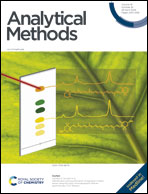Analysis of O-acetylated sialic acids by 3-nitrophenylhydrazine derivatization combined with LC-MS/MS†
Abstract
Sialic acids are a family of monosaccharides that share a nine-carbon backbone and a carboxyl group. A recent derivatization method based on 3-nitrophenylhydrazine (3-NPH) provides a mild chemical labeling technique for biomolecules containing carbonyl or carboxyl groups. In this study, we utilized 3-NPH to label sialic acids via a two-step derivatization process. The derivatized species can produce a common reporter ion corresponding to C1–C3 with two labels, and a fragment differentiating between Neu5Ac, Neu5Gc, and KDN. This method is compatible with O-acetylated sialic acids and provides high sensitivity to Neu5Gc and KDN, and since the utilization of dual labeling significantly enhances the hydrophobicity of derivatives, it can effectively mitigate matrix effects when combined with parallel reaction monitoring technology. Negative-ion tandem mass spectrometry (MS/MS) analysis reveals a distinctive fragmentation profile for the 4-O-acetylated species, while the other sialic acids yield similar MS/MS spectra with a high abundance of reporter ions. Using the reporter ion as a transition, this analytical strategy is effective for analyzing complex biological samples. For example, it was successfully employed to quantify sialic acids in the intestinal tissues of several carp species, demonstrating its potential in sialylation research.

- This article is part of the themed collection: Analytical Methods HOT Articles 2024


 Please wait while we load your content...
Please wait while we load your content...